Vistula-Oder operation. Part of 2
At 5 a.m. on January 12, 1945, the offensive of the 1st Ukrainian Front began. As Konev recalled, the offensive began in difficult weather conditions, there was almost no visibility, it was thick snow. On the one hand, this created an additional disguise for the ground forces. On the other hand, aviation could not support the infantry and Tanks. In addition, it was difficult to monitor the situation on the battlefield. However, the plan of the operation was so well prepared that the artillery preparation, the breakthrough of the enemy’s defense and the introduction of mobile units into the breakthrough went smoothly. Konev wrote: “All our plans on this day were carried out with special punctuality, which, I must say, is not so often achievable in the war ...”
The artillery preparation and the blow of the Soviet troops were so crushing that the captured German commanders admitted that the troops in a number of cases lost all self-control and left their positions without permission. The fire was so merciless that the survivors could not stand it and fled. At the same time, the German reserves were located in close proximity to the front, as a result of which, at the very beginning of the battle, they were hit by Soviet artillery and suffered serious losses. In order to save at least some of the troops and somehow delay the further offensive of the Soviet troops, the German command quickly hurried away the defeated units to the second line of defense. The withdrawal of German troops took place under the continuous strikes of Soviet artillery.
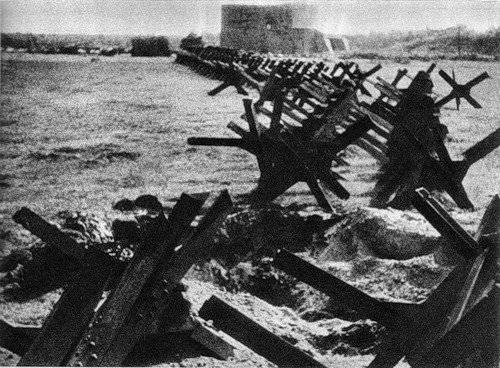
Strengthening the Middle European shaft
On the very first day of the battle, 3-I Guards Army of Gordov, 13-I Army of Pukhov, 52-I of Koroteev, 5-I Guards Zhadova made their way into the depth of 15-20 km and, breaking through the main line of German defense, widened the front line by 40 -60 km. Such a successful launch of the offensive enabled the introduction of Rybalko and Lelyushenko’s tank formations into the breakthrough already in the middle of the first day of the offensive. Therefore, when the German command attempted to organize a counter-attack with the help of two tank and two motorized divisions in reserve, it failed. When the German troops prepared for a counterattack, our tank units were already in the area of their location.
Thus, on the very first day, the troops of the 1 of the Ukrainian Front not only broke through the enemy defenses, creating a huge gap, overturning the first echelon divisions, but also smashed large mobile reserves, which suffered great losses during artillery preparation. The breakthrough of the Soviet troops was so deep that it was already impossible to eliminate it.
On the same day, the troops of the 4 of the Ukrainian Front (the West Carpathian operation) launched an offensive. On January 13, the troops of the 2 and 3 of the Belorussian fronts (East Prussian operation) launched an offensive. On January 14, after the enemy’s 25-minute artillery preparation, the troops of the 1-Byelorussian Front attacked. The main line of enemy defenses at the Vylensky line was broken through. To restore the front of the 4 Tank Army, Adolf Hitler ordered a tank corps to be transferred from East Prussia to the районód, region, which received the task of delivering a counterstrike in a southerly direction and eliminating the breakthrough on the front of Army Group A. In addition, additional forces were transferred from the Western Front. The German command still hoped to restore the front.
However, to stop the attack of Zhukov’s troops failed. The offensive of the Soviet troops was so swift and powerful that the German reserves were defeated and overthrown, without even having enough time to turn around. By the evening of January 15 there was no longer a solid German front. Under the threat of encirclement was the Warsaw group of the enemy, which was still defending itself on the Vistula in the area of Warsaw and to the south. The German command did not have large reserves capable of changing the situation. On January 17, the commander of Army Group A, Colonel-General Josef Garpe, and the commander of the 9 Army, General Smilo von Luttwitz, were removed from command of the troops. However, the change of command could not change the situation. By January 18, the main forces of Army Group “A” suffered a crushing defeat, the German defense was broken through on the 500-km front to a depth of 100 — 150 km.
Already on the fourth day of the operation, troops of the 1 of the Ukrainian Front advanced 100 km deep into the enemy’s territory and liberated the large city of Kielce. On January 17, Zhadov’s guards and Rybalko’s tankmen liberated the city of Czestochowa. And parts of the 60 Army of Kurochkin and the 59 Army of Korovnikov started fighting on the outskirts of Krakow. On the same day, Polish and Soviet troops broke into Warsaw. January 19, the troops of the 1 of the Belorussian Front took Lodz, January 23 took Bydgoszcz and started fighting for Poznan.
The connections of the 1 of the Ukrainian 19 front of January liberated Krakow from the Nazis. As Konev commander noted, having put the German troops in front of a real threat of coverage and encirclement, our troops, with their skillful actions, were able to preserve the most ancient and beautiful Polish city, the old capital of Poland, unharmed. Although the Nazis wanted to barbarously destroy the ancient city. Ahead of the Red Army, several reconnaissance groups were proceeding, who by their skillful actions thwarted the plan of the Nazis to destroy the city and explode dams for its flooding. In the same period, Soviet troops liberated Auschwitz and the territory of a large concentration camp there.
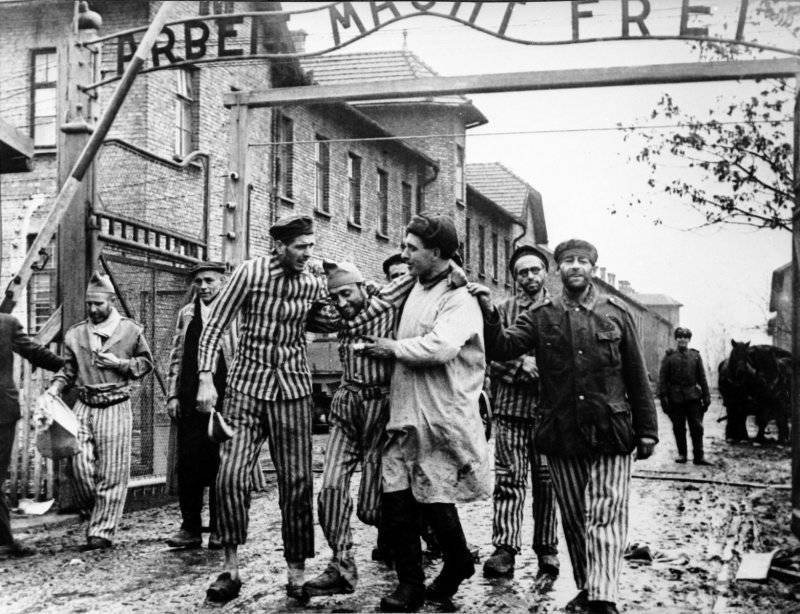
The liberated survivors of the Auschwitz concentration camp prisoners are taken out of the camp
The offensive of the Soviet troops developed so quickly that the enemy’s forces remained fairly significant. As Marshal Konev wrote, the Soviet command did not even try, by all means, to create around the enemy’s groupings a double encirclement ring (internal and external fronts). “We considered and correctly believed that if we were to develop an offensive at a sufficiently rapid pace, then we would not be afraid of the already serious enemy forces that had been cut off and remaining in our rear. Sooner or later they will be crushed and destroyed by the second echelon of our troops. ” Due to the fast pace of the movement, Konev's troops quickly overcame the intermediate zone of the German defense on the Nida River, and forced the Pilica and Warta rivers. Soviet troops reached the line of the rivers even before the retreating German troops. During these battles, the main forces of the 4 Tank Army and the 24 Tank Corps were defeated. German 17-I field army suffered huge losses.
On January 22, Konev's troops reached the Oder and began crossing to the north-west of Oppeln. To fulfill Joseph Stalin's instructions to preserve the “golden” Silesian industrial region, Ivan Konev decided not to surround the German troops, leaving them free to exit and destroy them later. By January 29, the entire Silesian industrial area was cleared of the Nazis and occupied by the intact. The task set by the rate was completed. As the marshal recalled, many enterprises continued to operate and manufacture products when Soviet troops entered Silesia.
Marshal of the Soviet Union Georgy Zhukov recalled that on January 25 the Supreme Commander had called him and, after hearing the report, asked what the front command was planning to do next. Zhukov said that the enemy was demoralized and offered to continue the offensive in order to capture the bridgehead on the Oder. The main direction of the attack was on Kustrin (Kostrzyn). The right wing of the front turned on the Pomeranian direction. After some deliberation, Stalin: the 2 of the Byelorussian Front had not yet completed the operation in East Prussia, and the right flank of the 1 of the Byelorussian Front was open, and agreed to continue the offensive. Concerns about the stakes of danger from the East Pomeranian grouping were quite reasonable. As subsequent events showed, the threat from Eastern Pomerania was constantly increasing.
As a result, the command of the 1 of the Byelorussian and 1 of the Ukrainian Fronts decided to continue the offensive without a noticeable pause. Meanwhile, the German command began transferring troops from the calmest sectors of the front, from the Western front, as well as internal reserves from the territory of Germany. But attempts to stabilize the broken front did not have much success.
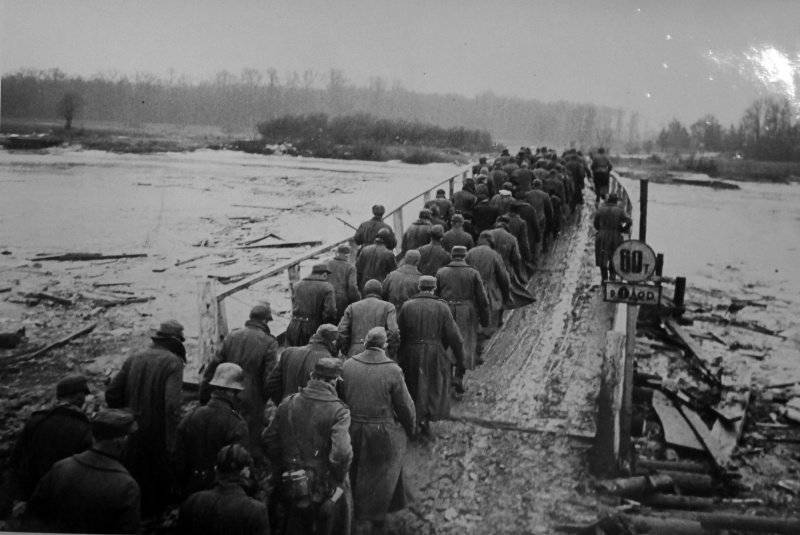
A column of captured Germans sent to the rear of the 1 of the Ukrainian Front
20-25 January, the troops of the 1 of the Belorussian Front broke through the Wartov and Poznan defensive lines. 60-ths hit the environment ring Poznan group. The liquidation of the Poznań garrison dragged on until February 23 1945. The Schneidemul enemy grouping was also surrounded. January 22 - February 3 Soviet troops reached the Oder River and captured bridgeheads on its western bank in the areas of Kustrin, Frankfurt, Steinau, Breslau and Oppeln.
The appearance of Soviet troops in 60-70 km from Berlin was a shock for the German command. Powerful defensive lines between the Vistula and the Oder fell in a very short time. The plan of the German command for the long delay of the Red Army on the predpolye of Germany collapsed. We had to take extraordinary measures to create a sustainable line of defense on the Oder.
However, at this turn the Soviet offensive was stopped. The troops of Zhukov, who occupied positions at Kustrin and Frankfurt, escaped the furthest. However, in order to start the Berlin operation, it was necessary to conduct appropriate training. The troops suffered serious losses, the rear left behind. It was necessary to complete the ammunition, fuel, medicines, spare parts, etc. Give the troops a break. Supplies had to be brought from warehouses that were still located on the eastern bank of the Vistula. Front-line infrastructure could not keep up with the combat units that had fallen far ahead. Thus, the commander of the 8 Guards Army Chuikov reported to Zhukov that the provision of ammunition in the army was only an average of 0,3-0,5 ammunition, and the 43-I cannon brigade was simply unable to move further, since the tractor crumbled due to the lack of spare parts and repair was impossible . In order to somewhat improve the situation, the 8 of the Guards Army had to use trophy in battles to expand the bridgehead. weapon and ammunition. Similar reports were received from other armies.
Zhukov in the Berlin direction had only four combined arms and two tank armies, drained of in the previous battles. Moreover, part of the forces of this grouping was connected with the liquidation of the Poznań grouping and the siege of Kustrin. The rest of the army 1 of the Byelorussian Front were deployed to the north, on the Pomeranian direction. In Eastern Pomerania, the German command assembled an attack fist and put up fierce resistance to the Soviet troops, who continued to move through the territory of northern Poland.
Thus, in the north, at the 1 of the Byelorussian Front, a front stretched for hundreds of kilometers was formed. This did not allow the formation of a group strong enough for the storming of the Berlin fortified area in the Berlin area. In addition, one had to beware of the blow of German troops in the flank and rear of the front. There was a huge, almost unsecured gap between 1 and 2 of the Belarusian fronts, which needed to be eliminated. The troops of Rokossovsky were tied up with heavy fighting to eliminate the East Prussian enemy grouping, which relied on powerful defense and objectively could not go level with the Zhukov armies.
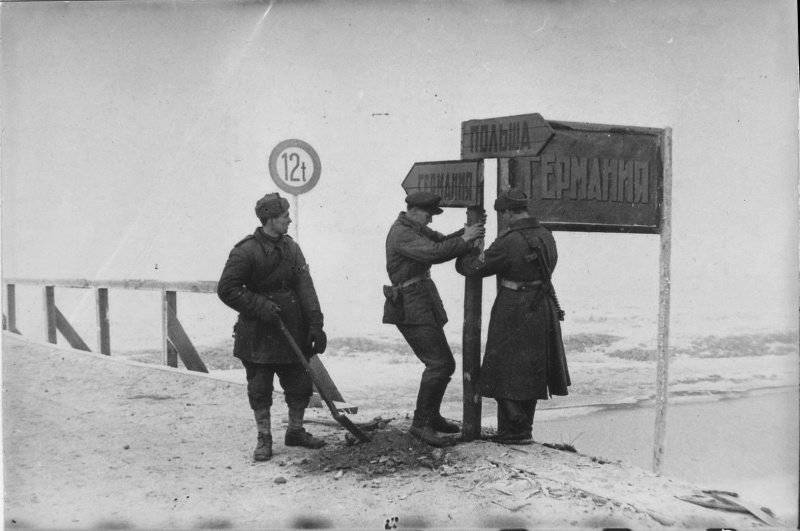
Soviet soldiers set up a border post between Poland and Germany on the bridge over the Oder
Results
1. For the 23 day, the Soviet forces advanced to the depth of 500 - 600 km, extended the breakthrough to 1 thousand km, and forced the Oder on the move. The territory of Poland to the west of the Vistula was liberated, which made it possible to proceed with the restoration of Polish statehood. Also, Soviet troops liberated a significant part of Czechoslovakia.
2. The Wehrmacht suffered a heavy defeat. The Germans lost the defensive line on the Vistula, the enemy's 35 divisions were completely defeated, another 25 lost between half and two-thirds of manpower. German troops got into the "boilers" in Poznan and Breslau. Only captured about 150 thousand people. According to Konev, only the troops of the 1 of the Ukrainian Front destroyed more than 150 thousand enemy soldiers and officers, captured 43 thousand people. Among the trophies captured by armies were more than 5 thousand guns and mortars, more 300 tanks, more 200 aircraft and a large number of other weapons and equipment. The total losses of the Soviet troops were about 160 thousand people.
To restore the front, the German command had to abandon active operations in the Ardennes and Alsace on the Western Front. The 6 SS army and a number of other formations were transferred to the Eastern Front. In total, the 1945 of the most combat-capable Wehrmacht divisions, including 13 tank and motorized, 6 tanks and assault guns, were transferred eastward in the second half of January - early February 800. However, the Germans failed to fully restore the defensive orders on the Eastern Front. The German plan to create a “German fortress” with a strategic assumption on the territory of Poland, East Prussia, Czechoslovakia, Hungary and Austria was crumbling before our eyes.
3. A huge wedge was hammered into the enemy’s strategic front, the point of which was located at Kustrin, and was sent to the German capital. The troops of the 1 of the Byelorussian Front reached the Oder and forced it on a number of sectors. Thus, the bridgehead was used, later used in the attack on Berlin. In addition, prerequisites were created for the success of the East Pomeranian operation. 1-th Ukrainian front also went to the Oder in its upper and middle course, creating a threat to the German army in the Berlin and Dresden sectors.
4. The tremendous success in the Vistula-Oder operation was of great military-strategic and political importance. Not only Germans were forced to admit it, but also allies. The Allied command had to admit the fact that Soviet troops would take Berlin.
It is also worth noting that if we take the operation as a whole and compare the losses of our troops with the results achieved, then it is obvious that this victory went to the Red Army with less blood than victories in some earlier operations. This was an indicator of the increased military skill of the Soviet commanders and troops, as well as the result of a seriously increased technical equipment of the formations.
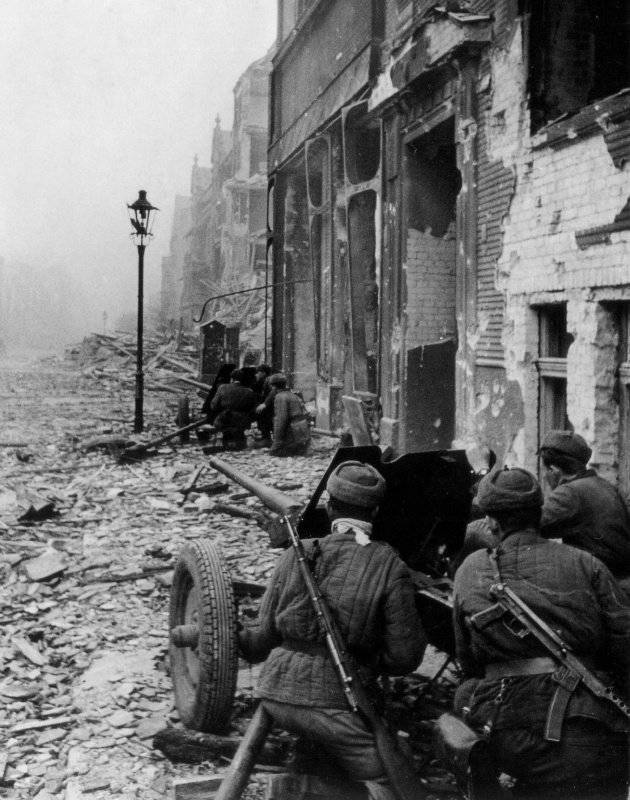
The gunners of one of the 6 Army Infantry Divisions are firing 45-mm 53-K guns at an enemy stronghold on Gutenberg-Strasse in the city of Breslau. 1-th Ukrainian Front. Photo source: http://waralbum.ru/
Sources:
Yemelyanov Yu.V. Ten Stalinist strikes. The triumph of the generalissimo. M., 2006.
Zhukov G. K. Memoirs and reflections. The 2 T. T. 2. M., 2002.
Isaev A. 1945 th ... Triumph in the offensive and defense. From Vistula-Oder to Balaton. M., 2009.
Konev I.S. Forty-fifth. M., 1970 // http://militera.lib.ru/memo/russian/konev_is2/index.html.
Samsonov A.M. The Second World War. 1939 — 1945 (Collapse of Fascist Aggression. 1939 — 1945). M., 1975.
Tippelskirch K. History World War II. SPb., M., 1999 // http://militera.lib.ru/h/tippelskirch/index.html.
Information